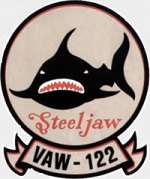Hobby Master HA4810 US Navy Northrop Grumman E-2C Hawkeye AEW Aircraft - VAW-122 "Steeljaws", USS Forrestal (CV-59), 1991 (1:72 Scale)
"Obsolete weapons do not deter."
- British Prime Minister Margaret Thatcher
 The Northrop Grumman E-2 Hawkeye is an American all-weather, carrier-capable tactical airborne early warning (AEW) aircraft. This twin-turboprop aircraft was designed and developed during the late 1950s and early 1960s by the Grumman Aircraft Company for the United States Navy as a replacement for the earlier E-1 Tracer, which was rapidly becoming obsolete. The aircraft's performance has been upgraded with the E-2B, and E-2C versions, where most of the changes were made to the radar and radio communications due to advances in electronic integrated circuits and other electronics. The fourth version of the Hawkeye is the E-2D, which first flew in 2007. The E-2 was the first aircraft designed specifically for its role, as opposed to a modification of an existing airframe, such as the Boeing E-3 Sentry. Variants of the Hawkeye have been in continuous production since 1960, giving it the longest production run of any carrier-based aircraft.
The Northrop Grumman E-2 Hawkeye is an American all-weather, carrier-capable tactical airborne early warning (AEW) aircraft. This twin-turboprop aircraft was designed and developed during the late 1950s and early 1960s by the Grumman Aircraft Company for the United States Navy as a replacement for the earlier E-1 Tracer, which was rapidly becoming obsolete. The aircraft's performance has been upgraded with the E-2B, and E-2C versions, where most of the changes were made to the radar and radio communications due to advances in electronic integrated circuits and other electronics. The fourth version of the Hawkeye is the E-2D, which first flew in 2007. The E-2 was the first aircraft designed specifically for its role, as opposed to a modification of an existing airframe, such as the Boeing E-3 Sentry. Variants of the Hawkeye have been in continuous production since 1960, giving it the longest production run of any carrier-based aircraft.
The E-2 also received the nickname "Super Fudd" because it replaced the E-1 Tracer "Willy Fudd". In recent decades, the E-2 has been commonly referred to as the "Hummer" because of the distinctive sounds of its turboprop engines, quite unlike that of turbojet and turbofan jet engines. In addition to U.S. Navy service, smaller numbers of E-2s have been sold to the armed forces of Egypt, France, Israel, Japan, Mexico, Singapore and Taiwan.
Pictured here is a 1:72 scale replica of a USN Northrop Grumman E-2C Hawkeye AEW Aircraft that was attached to VAW-122 "Steeljaws", then embarked upon the USS Forrestal (CV-59) during 1991.
Sold Out!
Dimensions:
Wingspan: 13-1/2-inches
Length: 9-3/4-inches
Release Date: September 2018
 Historical Account: "Steel Jaws" - Carrier Airborne Early Warning Squadron 122 (VAW-122) was an aviation unit of the United States Navy in service from September 1st, 1967 to March 31st, 1996. Originally nicknamed the "Hummer Gators" and later as "Steeljaws" was a U.S. Atlantic Coast Carrier Airborne Early Warning Squadron stationed at NAS Norfolk. During its 30 years of existence, the squadron was deployed around the world and saw action from Vietnam to Desert Storm, conducting operations from the Arctic to the tropics.
Historical Account: "Steel Jaws" - Carrier Airborne Early Warning Squadron 122 (VAW-122) was an aviation unit of the United States Navy in service from September 1st, 1967 to March 31st, 1996. Originally nicknamed the "Hummer Gators" and later as "Steeljaws" was a U.S. Atlantic Coast Carrier Airborne Early Warning Squadron stationed at NAS Norfolk. During its 30 years of existence, the squadron was deployed around the world and saw action from Vietnam to Desert Storm, conducting operations from the Arctic to the tropics.
VAW-122 made its first major counter-narcotic deployment as a squadron to the Caribbean and Central America in 1990, previously it had been smaller detachments of shorter duration beginning in 1983 with Operation Thunderbolt. In 1992, it became permanently assigned to the role of counter-narcotic. By 1996, the unit had completed eight deployments in the Caribbean and Eastern Pacific areas, conducting some missions deep over South or Central America, and far into the Pacific Ocean -- and was credited with the seizure of more than 16 metric tons of illegal drugs.
VAW-122 was disestablished at NAS Norfolk on March 31st, 1996. Its drug-interdiction mission and aircraft were assumed by VAW-77, stationed at NAS Atlanta.









